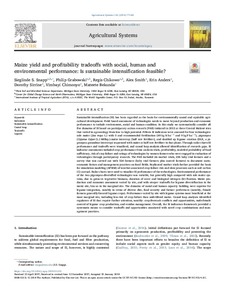| dc.contributor.author | Snapp, Sieglinde S. |
| dc.contributor.author | Grabowski, Philip |
| dc.contributor.author | Chikowo, Regis |
| dc.contributor.author | Smith, A. |
| dc.contributor.author | Anders, E. |
| dc.contributor.author | Sirrine, D. |
| dc.contributor.author | Chimonyo, V.G.P. |
| dc.contributor.author | Bekunda, Mateete A. |
| dc.date.accessioned | 2019-12-04T11:14:26Z |
| dc.date.available | 2019-12-04T11:14:26Z |
| dc.date.issued | 2018 |
| dc.identifier.citation | Snapp, S.S., Grabowski, P., Chikowo, R., Smith, A., Anders, E., Sirrine, D., ... & Bekunda, M. (2018). Maize yield and profitability tradeoffs with social, human and environmental performance: is sustainable intensification feasible? Agricultural Systems, 162, 77-88. |
| dc.identifier.issn | 0308-521X |
| dc.identifier.uri | https://hdl.handle.net/20.500.12478/2761 |
| dc.description.abstract | Sustainable intensification (SI) has been regarded as the basis for environmentally sound and equitable agricultural development. Field based assessment of technologies needs to move beyond production and economic performance to include environment, social and human condition. In this study we systematically consider all five domains of SI based on participatory action research (PAR) initiated in 2012 at three Central Malawi sites that varied in agroecology from low to high potential. Fifteen SI indicators were assessed for four technologies: sole maize (Zea mays L.) with 0 and recommended fertilization (69 kg N ha−1 and 9 kg P ha−1), pigeonpea (Cajanus Cajun (L.) Millsp.)-maize intercrop (half rate fertilizer), and doubled up legume rotation (DLR, a pigeonpea-
groundnut intercrop) sequenced with maize at half rate fertilizer in that phase. Through radar charts SI performance and tradeoffs were visualized, and causal loop analysis allowed identification of research gaps. SI indicator assessments included crop performance from on-farm trials, profitability, modeled probability of food sufficiency, risk of crop failure and ratings of technologies by women farmers who were engaged in evaluation of technologies through participatory research. The PAR included six mother trials, 236 baby trial farmers and a survey that was carried out with 324 farmers (baby trial farmers plus control farmers) to document socioeconomic factors and management practices on focal fields. Replicated mother trials further provided the basis for simulation modeling (APSIM) of weather-associated crop failure risk and slow processes such as soil carbon (C) accrual. Radar charts were used to visualize SI performance of the technologies. Environmental performance of the two pigeonpea-diversified technologies was variable, but generally high compared with sole maize systems, due to gains in vegetative biomass, duration of cover and biological nitrogen (N) fixation. Maize production and economic assessment varied by site, and with steeper tradeoffs for legume diversification in the mesic site, less so in the marginal site. The domains of social and human capacity building were superior for legume integration, notably in terms of diverse diet, food security and farmer preferences (notably, female farmers generally favored legume crops). Performance varied by site with legume systems most beneficial at the most marginal site, including less risk of crop failure than unfertilized maize. Causal loop analyses identified regulators of SI that require further attention, notably: crop-livestock conflicts and opportunities, male-female control of legume crop production, and residue management. Overall, the SI indicators framework provided a systematic means to consider tradeoffs and opportunities associated with novel crop combinations and management
practices. |
| dc.description.sponsorship | United States Agency for International Development |
| dc.format.extent | 77-88 |
| dc.language.iso | en |
| dc.subject | Indicators |
| dc.subject | Legumes |
| dc.subject | Maize |
| dc.subject | Crop Production |
| dc.subject | Malawi |
| dc.subject | Sustainable Intensification |
| dc.subject | Causal Loop |
| dc.subject | Trade-Offs |
| dc.subject | Maize Yield |
| dc.title | Maize yield and profitability tradeoffs with social, human and environmental performance: is sustainable intensification feasible? |
| dc.type | Journal Article |
| dc.description.version | Peer Review |
| cg.contributor.crp | Maize |
| cg.contributor.affiliation | Michigan State University |
| cg.contributor.affiliation | International Institute of Tropical Agriculture |
| cg.coverage.region | Africa |
| cg.coverage.region | Southern Africa |
| cg.coverage.country | Malawi |
| cg.creator.identifier | Mateete Bekunda: 0000-0001-7297-9383 |
| cg.isijournal | ISI Journal |
| cg.authorship.types | CGIAR and advanced research institute |
| cg.iitasubject | Maize |
| cg.iitasubject | Plant Production |
| cg.journal | Agricultural Systems |
| cg.howpublished | Formally Published |
| cg.accessibilitystatus | Open Access |
| local.dspaceid | 93859 |
| cg.targetaudience | Scientists |
| cg.identifier.doi | https://doi.org/10.1016/j.agsy.2018.01.012 |

